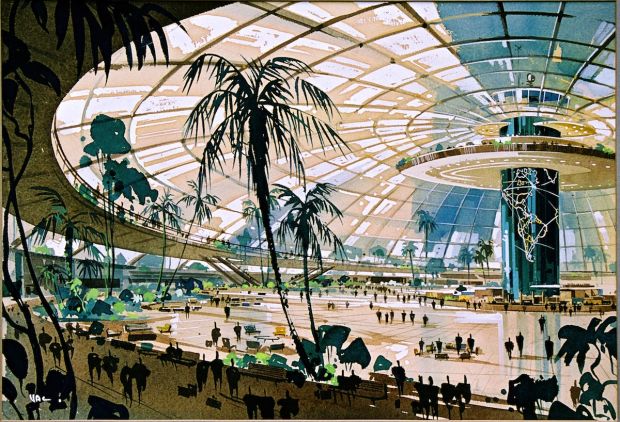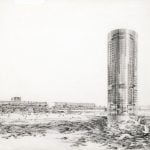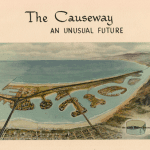
Would you ever drive from Malibu to Santa Monica on a freeway that stretched across the Santa Monica Bay?
Apparently someone thought you would, because in 1965 a causeway connecting the two cities was planned to span the bay. However, despite repeated efforts by backers, it never left the blueprint stage.
The project was the brainchild of John Drescher, a millionaire engineer in Santa Monica whose company, Drescher Engineering, saw its value skyrocket in the heady era of 1950s and 1960s Los Angeles. At the time, Drescher lived in a six-acre artists’ haven in Santa Monica called “Drescherville” with a pet parakeet and an adopted rat, according to the Santa Monica College website. Drescher, who passed away in 2000 at age 89, was also a philanthropist who gave generously to Pepperdine University and Santa Monica College.
The causeway is just one of the many designs and models of unfinished LA development projects on display at the new Never Built: Los Angeles installation at the A+D Museum.
The exhibit tells a story that curiously mirrors Los Angeles’ own, not by showing off what was built, but by showcasing what wasn’t.
The resulting narrative is as densely packed with political intrigue as Roman Polanski’s “Chinatown” and as sprawling as the city itself.
“I think a lot of these schemes seem very romantic when you see them on paper,” said Sam Lubell, a co-curator of the exhibit. “It’s also part of the mystique of this show. Everything’s suspended in this amazing dream vision of what could have been.”
The exhibit first took shape four years ago when Tibbie Dunbar, director of the A+D Museum, was granted permission to borrow some items from the Getty Museum’s collection, Lubell said.
Dunbar was inspired by plans for unfinished projects in Los Angeles, and she approached Lubell and Greg Goldin to create an exhibit from them.
Lubell and Goldin were both experienced in architecture and journalism. Lubell studied architectural history at Brown University and worked as a freelance writer before moving to Los Angeles to edit the West Coast edition of The Architect’s Newspaper.
Originally the exhibit was meant to showcase the last 20 years of planned architecture in Los Angeles, Lubell said.
However, it got bigger.
Their journalistic experience came in handy as Lubell and Goldin uncovered more and more abandoned projects.
“We did a lot of digging,” Lubell said.
Three years later, instead of covering the last two decades, Never Built: Los Angeles spanned more than a century.
The earliest planned project on display is a bicycle freeway proposed in 1900 by then Pasadena Mayor Horace Dobbins. It would have run from Pasadena to downtown Los Angeles on a raised track to the side of the Arroyo Seco.
Other unfinished works include a cylindrical glass tower rising out of the Santa Monica Bay, a necklace of parks throughout the city and along the coast, and a monolithic art deco civic center in downtown Los Angeles, designed by Lloyd Wright, son of legendary architect Frank Lloyd Wright, that looks like something straight out of the sci-fi movie “Blade Runner.”
“It’s overwhelming, that kind of ambition,” Lubell said. “Some of these ideas, people wouldn’t even dare to propose them in other cities.”
The proposed offshore freeway that would have run from Santa Monica to Malibu was to be a causeway built on landfills and surrounded by islands that would have provided housing for 29,000 people, Lubell said.
“It was definitely more than transportation,” Lubell said. “It was about development.”
Far more than a one-off idea, it was proposed repeatedly; interested parties included the U.S. Army Corps of Engineers and the California Department of Transportation.
“It was very close to happening,” Lubell said.
However, coastal residents concerned about overdevelopment and the safety of the Santa Monica Bay killed its construction.
“It spawned a new environmental movement in Santa Monica,” Lubell said.
The prospect of a highway running straight across Santa Monica Bay to Malibu raised more than a few eyebrows among visitors last weekend at the Malibu Art Festival. West Los Angeles resident Andrew McKechnie, who sometimes works in Malibu, said he probably would have used it, but said it is better it wasn’t built.
“It would have been catastrophic for the environment, the Santa Monica Bay, the marine life,” he said.
Edward Kooijman, who was vacationing in Malibu from the Netherlands, said he was surprised the causeway was never built.
Kooijman suggested that had it allowed foot traffic, the causeway might have provided an alternative to car-dominated roads and highways in Los Angeles.
“Maybe that’s why they made these plans,” he said.
In Europe, an offshore freeway would have been more likely, Kooijman said, as opposed to the Pacific Coast Highway.
“It’s too close to the coast,” he said.
Never Built: Los Angeles will be at the A+D Museum through Oct. 13, 2013. For more information visit www.aplusd.org/exhibitions-current.


